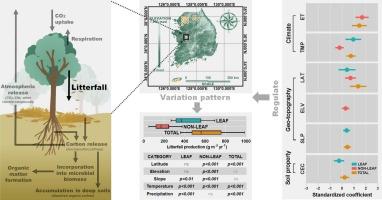Quantifying the variation patterns and environmental controls of forest litterfall: A regional synthesis of ecological data across South Korea
IF 8
1区 环境科学与生态学
Q1 ENVIRONMENTAL SCIENCES
引用次数: 0
Abstract
Enhancing the strength of forest carbon sinks is critical in the wake of the accelerating global climate change and intensifying greenhouse effect. However, the regional patterns and environmental controls of forest litter, a major carbon pool and entry pathway from tree-to-soil systems, remain uncertain. Herein, we consolidated up to a decade of data from six ecological studies (totaling 28 stands) conducted across South Korea between 1999 and 2022 (spanning 23 years) to examine variations in total and component-based litterfall with geo-topography and climate. Linear mixed-effects models for leaf, non-leaf, and total litterfall were further developed to understand mechanistic litter-environment relationships and identify key abiotic factors controlling regional litterfall. Our analysis reveals a pronounced latitudinal pattern in total litterfall, with >37°N zones generating up to 54 % less litter than areas of lower range (p < 0.001). Leaf and non-leaf fractions varied significantly with slope (p < 0.01 for leaf; p < 0.001 for non-leaf), while only non-leaf litter responded substantially to elevation (p < 0.001). Total litterfall increased with rising growth season temperature but decreased with increasing precipitation. Our top-performing models adequately captured litterfall variation, as evidenced by conditional R2 values of 0.77 (RMSE = 39.2 g m−2), 0.93 (28.9 g m−2), and 0.98 (7.4 g m−2) for non-leaf, leaf, and total litter, respectively. Climate emerged as the main regulating factor for coarse-scale litterfall, with evapotranspiration largely explaining total and non-leaf litter and temperature strongly relating to leaf litter. Large-scale conservation strategies should therefore consider regional abiotic variations to ensure stable plant-soil-atmosphere feedbacks and improve the preparedness of natural systems against the detrimental impacts of climate change.

量化森林凋落物的变化模式和环境控制:韩国生态数据的区域综合。
在全球气候变化加速和温室效应加剧的背景下,加强森林碳汇的强度至关重要。然而,森林凋落物作为一个主要的碳库和从树木到土壤系统的进入途径,其区域格局和环境控制仍然不确定。在此,我们整合了1999年至2022年(跨越23年)在韩国进行的六项生态研究(总共28个林分)长达十年的数据,以检查总凋落物和基于成分的凋落物随地理地形和气候的变化。进一步建立了叶片、非叶片和总凋落物的线性混合效应模型,以了解凋落物与环境的机制关系,识别控制区域凋落物的关键非生物因子。我们的分析表明,总凋落物具有明显的纬向格局,> - 37°N区域的凋落物产生量比低纬度区域少54% (p 2值分别为0.77 (RMSE = 39.2 g m-2)、0.93 (RMSE = 28.9 g m-2)和0.98 (RMSE = 7.4 g m-2)。气候是大尺度凋落物的主要调节因子,蒸散发在很大程度上解释了总凋落物和非凋落物,温度与凋落物密切相关。因此,大规模保护战略应考虑区域非生物变化,以确保稳定的植物-土壤-大气反馈,并改善自然系统对气候变化有害影响的准备。
本文章由计算机程序翻译,如有差异,请以英文原文为准。
求助全文
约1分钟内获得全文
求助全文
来源期刊

Science of the Total Environment
环境科学-环境科学
CiteScore
17.60
自引率
10.20%
发文量
8726
审稿时长
2.4 months
期刊介绍:
The Science of the Total Environment is an international journal dedicated to scientific research on the environment and its interaction with humanity. It covers a wide range of disciplines and seeks to publish innovative, hypothesis-driven, and impactful research that explores the entire environment, including the atmosphere, lithosphere, hydrosphere, biosphere, and anthroposphere.
The journal's updated Aims & Scope emphasizes the importance of interdisciplinary environmental research with broad impact. Priority is given to studies that advance fundamental understanding and explore the interconnectedness of multiple environmental spheres. Field studies are preferred, while laboratory experiments must demonstrate significant methodological advancements or mechanistic insights with direct relevance to the environment.
 求助内容:
求助内容: 应助结果提醒方式:
应助结果提醒方式:


